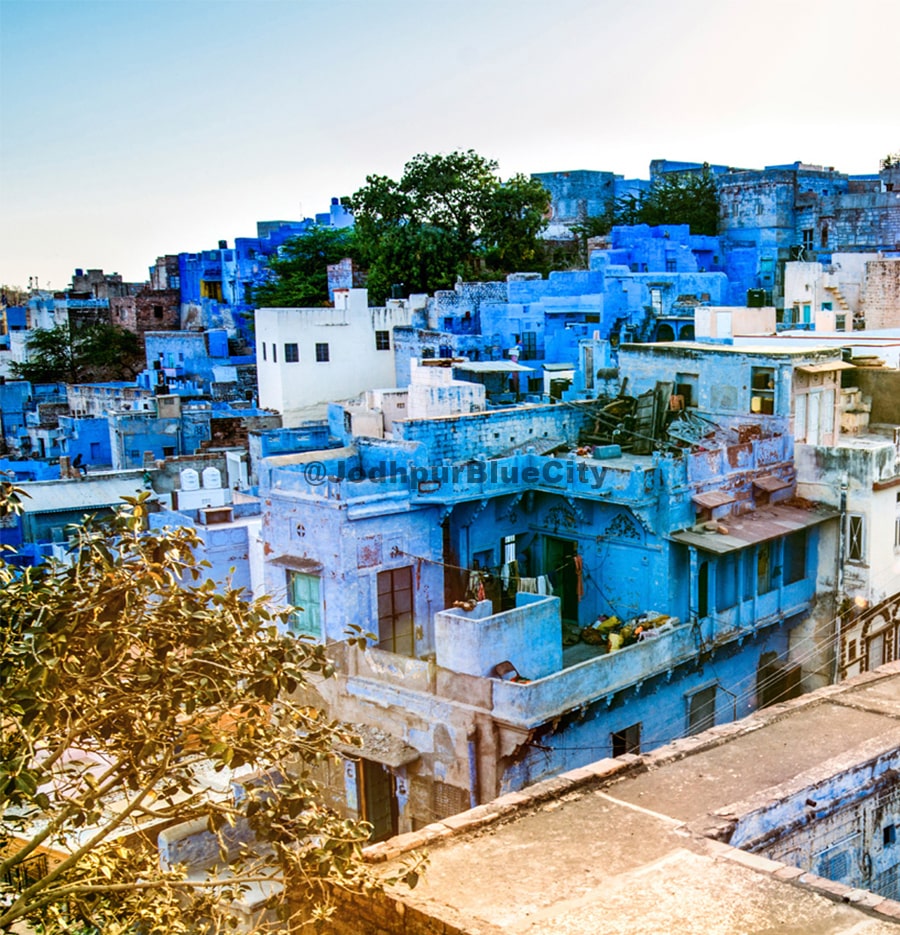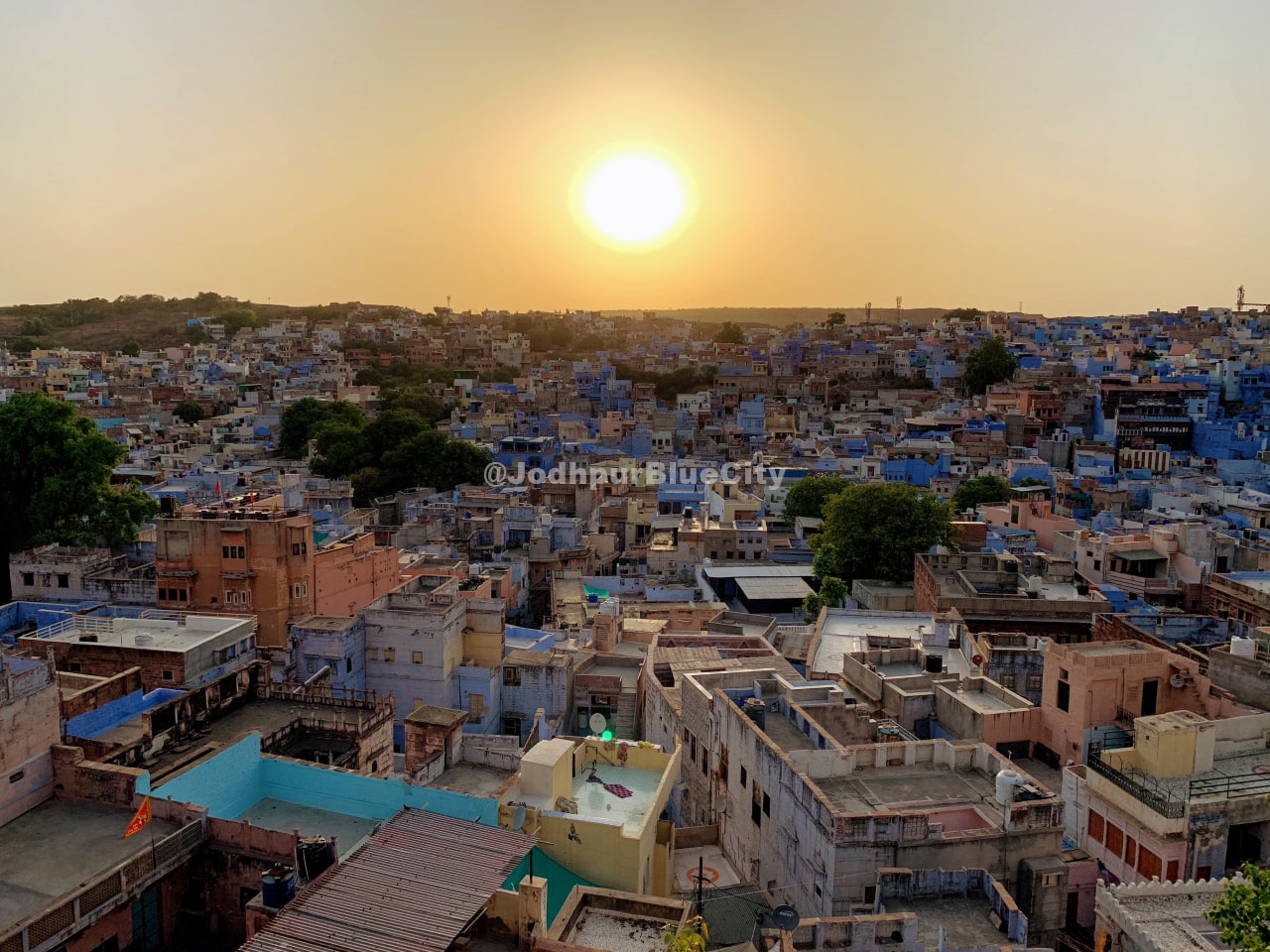Jodhpur The Blue City
Interesting Facts about Jodhpur:-
Jodhpur was founded by Rao Jodha, a Rajput chief of the "Rathore" clan. He built Mehrangarh Fort and the city was enclosed by tall and thick walls. There were Seven gates, those were used for transportation. At that time all the people were living in the wall covered city, and the gates were opened and closed at the fixed time.
Jodhpur is known as Best Tourist Attraction Place in Rajasthan because of its historical places and monuments. Jodhpur is the second-largest city of Rajasthan state and it is a famous tourist destination for domestic and international tourists.

Why Jodhpur is known as Sun City?
Jodhpur is known as Sun City because of the bright and sunny weather. Jodhpur is having bright and sunny weather all year and in summer sun shows its presence in Jodhpur, :P , even in winter Jodhpur enjoys bright sunlight in the afternoon.
Climate of Jodhpur -
Generally, Jodhpur's climate is dry, hot and sunny around all the year. This is the reason Jodhpur is called Sun City. Tourists can check this before their Jodhpur visit Jodhpur Climate

Why Jodhpur is known as Blue City?
Jodhpur is known as Blue City Of India because of blue-painted houses inside the old city (near Mehran Garh Fort Area) of Jodhpur. It is also called as Sun City because of the sunny weather, the sun shows its love to jodhpur all the year with its brightness LOL. Now we will talk about "History Of Jodhpur"

The Rich Cultural Heritage of Jodhpur
When Rao Jodha, a Rajputana chief, came to power 600 years ago, the tale of Jodhpur began. Within a year of taking power, he determined that Mandore, the former Rajput capital, was no longer secure. The capital was moved to Marwar, formerly known as Jodhpur, under his rule. Here's a bit of trivia for you: Since it is so similar to the unforgiving Thar desert, the name Marwar is derived from the Sanskrit word ‘Maruwat,' which means desert area. However, some scholars claim it is derived from the word ‘Maru-war,' which means death region. And, in case you didn't notice, Jodhpur takes its name from its first emperor, 'Rao Jodha.'
The blue buildings in Jodhpur were initially painted to indicate that they were inhabited by Brahmins, India's highest caste. Locals say that the hue helps keep the interiors cool and insects at bay today. However, we agree that painting the city in the colour of water will be a daring declaration about the desert people's durability in the face of their harsh and desolate climate. The handicrafts industry, which includes leather embroidery, white metal, wood and stone carvings, cloth dyeing and printing, and other decorative products, now accounts for a significant portion of the city's economy. The welcoming locals of Jodhpur will most certainly greet you with a warm smile, welcoming you to this wonderful city brimming with colours and rich heritage, studded with forts and temples and alive with festivals and fairs, offering an once-in-a-lifetime experience giving you the full essence of Rajasthan tourism! The best places to visit in Jodhpur make it easier to learn about the city's heritage and culture.
Forts, Museums, Adventures and so much more....
This list of the best attractions and best places to visit in Jodhpur will provide you with a varied view of the capital. The Jodhpur Heritage Walk offers a three- to four-hour trip of the district with experienced Jodhpur tour guides.
Mehrangarh Fort
obnoxious The Mehrangarh Fort, which towers above the "Blue City," is one of India's largest and most well-known forts. As spectacular as it is outside, there is so much more to experience inside as a well-preserved heritage building. The fort has been renovated privately, and its museum houses a remarkable array of royal objects, including nearly 15,000 pieces from Maharaja Gaj Singh II's personal collection. It also houses India's first professional museum store. Another highlight is the regular cultural events that take place in the fort as part of the fort's unique emphasis on folk art and culture. This detailed guide to Mehrangarh Fort will help you schedule your tour.
Jaswant Thada
The detailed carvings on the Jaswant Thada render it an architectural masterpiece. It was designed in 1899 by Maharaja Sardar Singh in memory of his father, Maharaja Jaswant Singh II, and is regarded as one of the most beautiful white marble cenotaphs in the world. The Taj Mahal of Marwar is the name given to this white marble wonder of Rajasthan. The majestic structure is a fine example of Rajputana architecture. Its impeccable style and construction are evocative of bygone period fine craftsmanship.
The main memorial is built in the style of a temple, with ornate domes and intricately carved sculptures. Beautiful portraits of the numerous rulers of Jodhpur can be found here. A monument to a peacock who crashed into a funeral pyre can also be found at the complex. The cremation ground is surrounded by magnificently carved gazebos, an exquisite multi-tiered greenhouse, and a small pool.
Umaid Bhawan Palace
This monument, also known as Chittar Palace, is divided into three sections: a heritage hotel, a museum, and the Maharaja's royal residence. The Umaid Bhawan Palace is one of Jodhpur's most opulent hotels. It is an architectural masterpiece with all new amenities and delivers a royal experience. Here you can find marble squash courts, billiards rooms, a private gallery, and much more. Royal artefacts and armour, antique clocks, glassware, and other miniatures are on display at the museum.
Sardar Samand Lake
Bird-watchers rejoice, as this lovely lake offers great opportunities to see migratory birds. Sardar Samand Lake, 60 kilometres south-east of Jodhpur, provides a tranquil atmosphere for tourists. You could see black bucks, neelgai, and chinkara on your way to the pool. Furthermore, this lake provides a lovely and relaxing respite from the hustle and bustle of city life.
Mahamandir Temple
Mahamandir, or the Great Temple, stands majestically tall on Mandore Lane. It houses numerous ancient shrines and is built on 84 massive pillars decorated with impeccable artistry in the form of carvings of various yogic postures. Traditional motifs adorn the walls and pillars of this building.
Chamundi Devi Temple
At the end of the Mehrangarh Fort is the famous Chamunda Devi Temple, which is dedicated to Goddess Durga. In 1460, Rao Jodha received the temple's main idol of Chamunda Mataji from Mandore. During the festival of Dussehra, millions of devotees flock to the fort to see the shrine.
Marwar Festival
Every year, in the months of September and October, a two-day festival is organised to honour Rajasthan's epic heroes. If you happen to be in Jodhpur at this moment, be prepared to see folk dancers put on a spectacular display depicting the regal lifestyle and real war tales of the Kings who ruled Rajasthan at the time. Aside from folk music and dancing, other forms of entertainment such as tattoos and polo also attract a considerable number of visitors.
Nagaur Fair
Prepare to attend India's second largest fair, the Nagaur Cattle Fair. Every year, in the months of January and February, an eight-day festival for animal trade is organised. Every year, the Nagaur fair trades about 70,000 painted pigs, bullocks, camels, and horses. Cattle owners aren't far away, since they, too, dress up for the event. Tug-of-war, camel and bullock races, cock fights, and a puppet show are among the other attractions at this fair.
Take a ride on the Flying Fox
Zip-lining with Mehrangarh Fort as a backdrop is a once-in-a-lifetime chance for explorers. Six zip lines make up the circuit, which takes about 90 minutes to complete. At predetermined hours,groups of up to 12 people leave. It can be found on the Mehrangarh Fort's north flank.
Plan your trip today!
The striking blue buildings of Jodhpur, which are surrounded by a massive fortress wall with bastions, contrast strongly and beautifully with the Thar Desert. The city's architectural grandeur welcomes you to visit the palaces, forts, and temples. Textiles, embroidered leather objects, lacquerware, antiques, carpets, puppets, and figurines and so much more to explore in the bazaars of Jodhpur. So visit this popular tourist destination of Rajasthan and have the experience of a lifetime!
